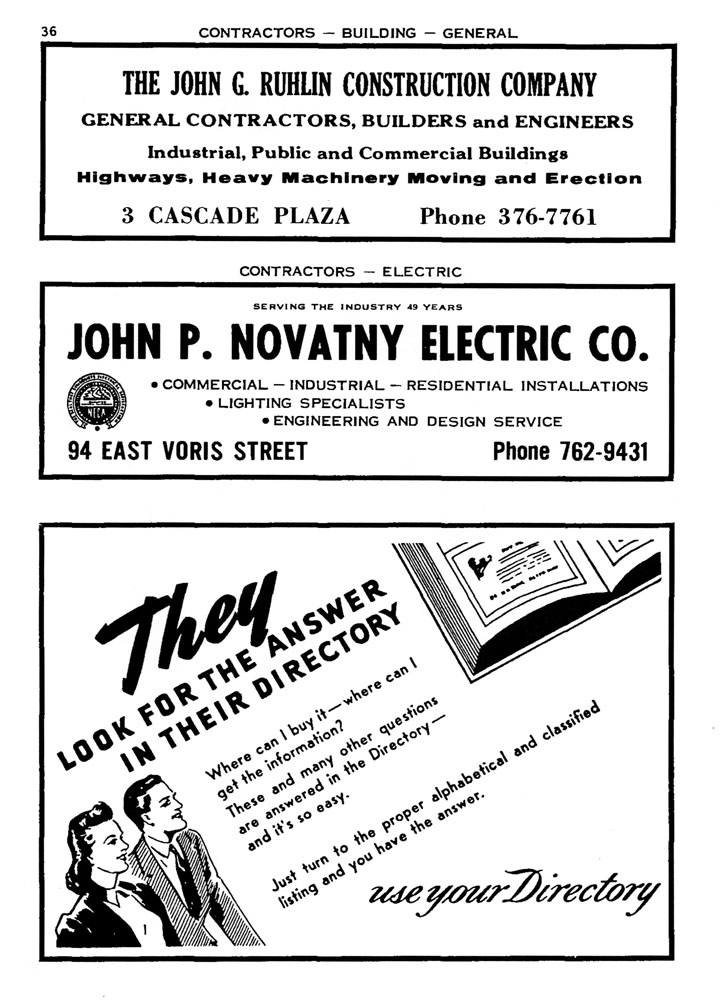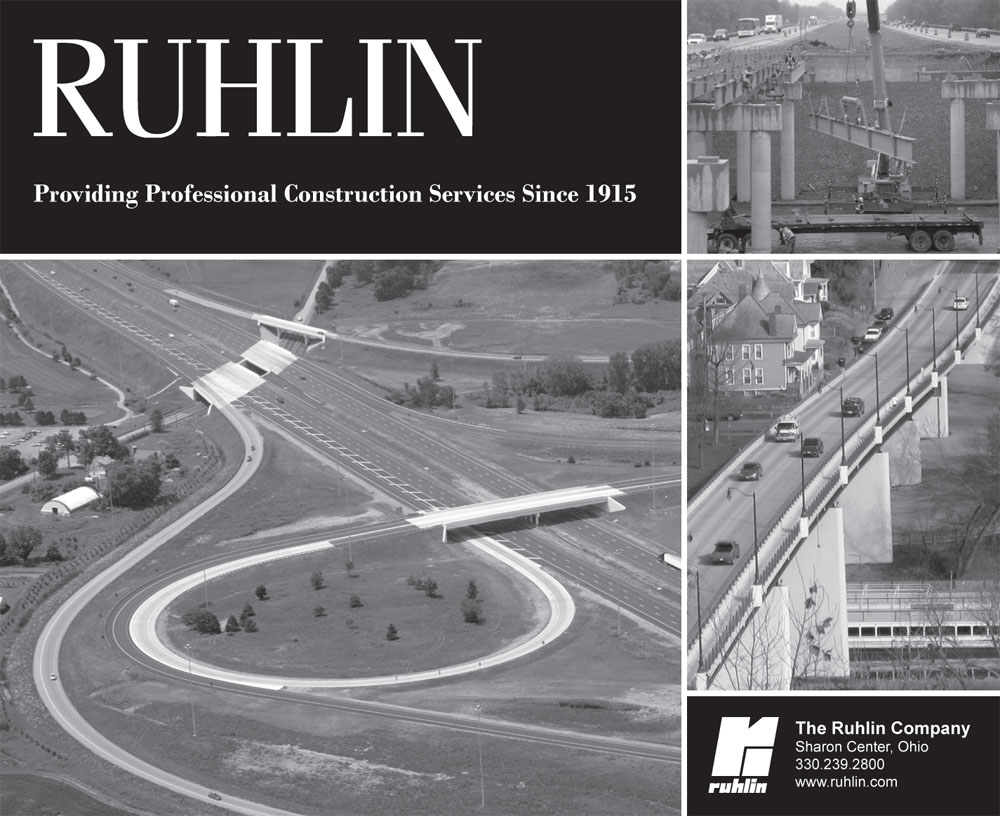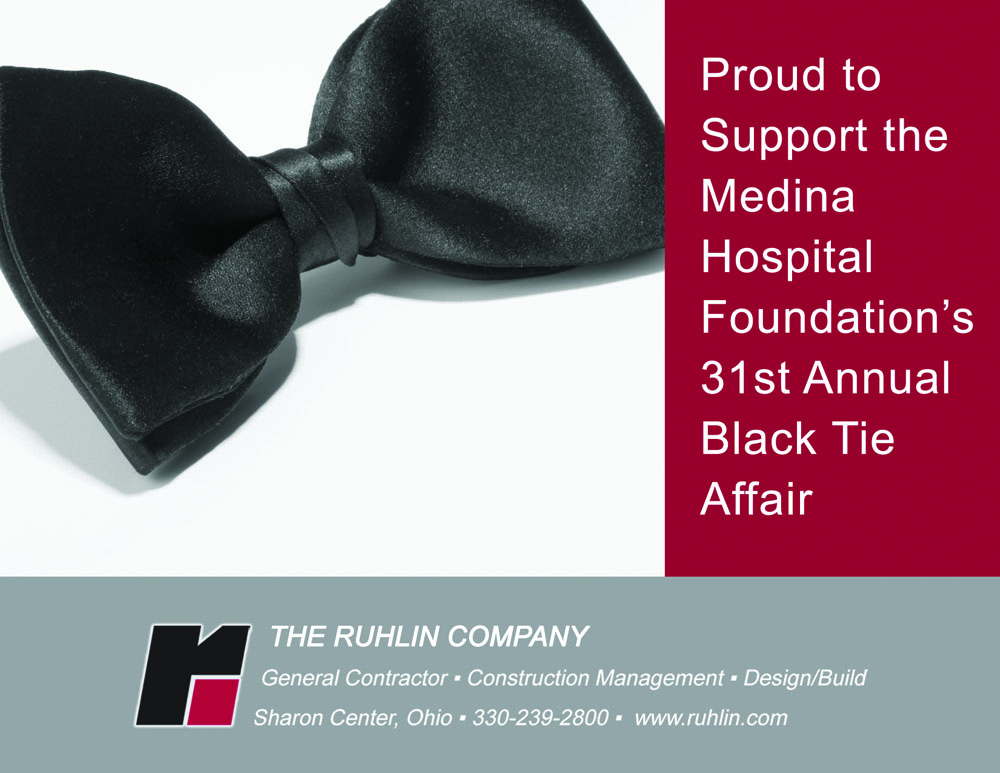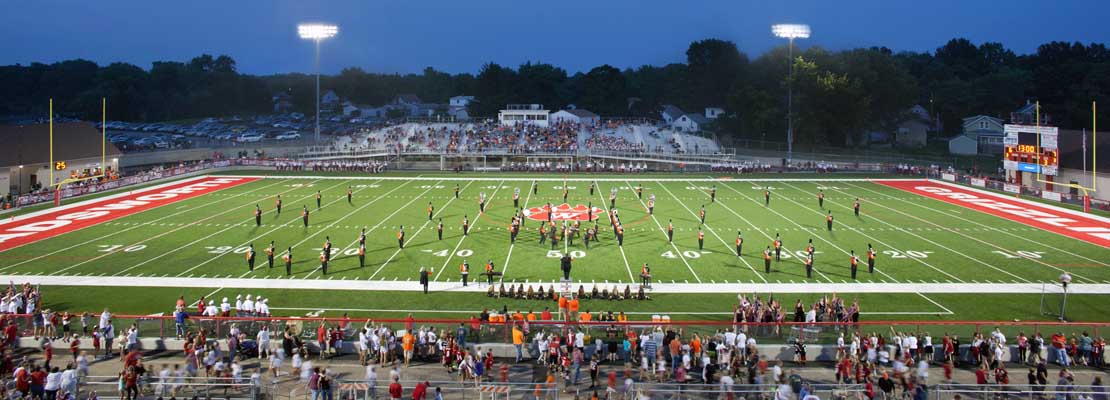COMPANY HISTORY
The Ruhlin Company was founded by John G. Ruhlin in 1915. Initially, the company offered its services as a General Contractor in the Commercial and Industrial markets of Northeast Ohio. Our first construction project was a school in Creston, Ohio. As the company grew, it expanded into the Civil market in 1955 to include constructing bridges, roads, sewers and water treatment facilities throughout the State of Ohio. In 1948, the company was incorporated under the name The John G. Ruhlin Construction Company. It operated under the founder’s name until 1980 when it was changed to its present form. We received ODOT prequalification in 1953. In 2003, the Industrial Division was resurrected and operated with its two sister divisions. The Structural Division was added in 2006 to complement our Heavy Civil division.
After John G. Ruhlin, his son Bill Ruhlin was named president in 1960. Ruhlin became an ESOP in 1977. John B. Ruhlin was named president in 1980. In 1996, James Ruhlin was made president making The Ruhlin Company a third generation led company.
The company originally was housed at John G. Ruhlin’s residence. In 1948, the company was relocated to Home Road in Akron, OH. In 1962, we purchased 75 acres in Sharon Center that would later become our headquarters. In 1969, Ruhlin moved to the newly constructed Cascade Plaza in downtown Akron. In 1984, we moved to Cleveland Massillon Road in Fairlawn. In 1989, we moved to the current location in Sharon Center to allow us to be close to our equipment and repair shop located on the site.
1964 Ruhlin appeared in ENR’s inaugural top 400 list. In its 50th year, Ruhlin remains on the list as one of the 18 companies to still be thriving fifty years later.
SUCCESS STORIES
LOGO EVOLUTION

HISTORICAL ADVERTISEMENTS

1948-1949
Akron Directory

1966-1967
Akron Directory

1968-1969
Akron Directory

1981
The Ruhlin Reporter

1982
The Ruhlin Reporter

1982
The Ruhlin Reporter

1998
Ohio Contractor
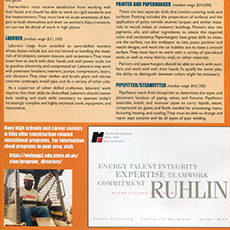
2005
Building Ohio

2009
American Heart Association

2009
Build Ohio

2010
Source Book

2011
Bridgestone

2012
OSBA Journal

2012
United Way

2012
Properties

2013
Medina Hospital

2013
Ohio Contractors Association

2013
Ruhlin Advertisement
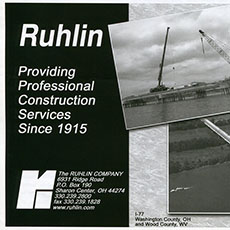
2014
Ohio Contractor

2014
NEOMED
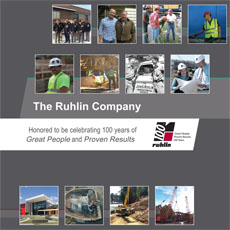
2015
Properties
DID YOU KNOW?
Weeks
Days
Hours
Minutes
CASE STUDIES
- Akron General Medical Center
- AMP Willow Island Powerhouse
- The University of Akron
- Wadsworth City Schools
BUILDING WITH CARE
THE RUHLIN COMPANY’S HISTORY OF SUCCESSFUL CONSTRUCTION PROJECTS AT AKRON GENERAL MEDICAL CENTER
PROACTIVE PROBLEM-SOLVING
Construction challenges are certain in any building program; and hospital settings, where patients need treatment regardless of construction plans, can be particularly challenging. Success depended on Ruhlin’s ability to anticipate needs and provide creative solutions to address issues before they became problems.
Even before Ruhlin broke ground on The Green Health & Wellness Center in Uniontown, the project began hitting roadblocks. AGMC’s project leaders, like Senior Vice President of System Operations, Stephen Abdenour, quickly learned that Ruhlin’s expertise spans the entire construction process, starting with finances.
“We ran into some issues on the frontend with the budget while the developer was putting the entire project together,” Abdenour says, explaining that the original estimates were low compared to the actual bids. “Ruhlin, as our general contractor, was very helpful in closing that budgetary delta through value engineering and through the expertise they were able to provide onsite. They were instrumental in helping us get that project from the design phase, into the ground and up-and-out construction-wise.”
Once construction began on Green in 2010, challenges continued. The facility, just like the one in Stow that Ruhlin completed in 2008, combined a conventional fitness center with diagnostic imaging, physical therapy and emergency care – on an aggressive schedule. Timelines were already tight when weather taxed the schedule further. August, typically a dry month, brought more than 20 inches of rain that year, requiring soil stabilization for the building foundation.
Ruhlin communicated problems to the hospital promptly to keep staff aware of potential obstacles, possible impacts to the schedule and proposed alternatives to address them, so none of the construction challenges surprised AGMC.
By approaching challenges with proactive problem-solving, Ruhlin made adjustments to keep the Health & Wellness Center construction moving seamlessly.
“On the Green project, it seems like we ran into every kind of obstacle you could run into,” Abdenour says. “We had an aggressive target – about an 11-month construction timeframe – and, Ruhlin hit it. Their expertise at being able to bring a project in within budget constraints and on time is huge for us.”
DEDICATION TO SUCCESS
Even after construction was complete, Ruhlin stayed on board to ensure a smooth transition of the building, working closely with hospital maintenance to explain HVAC systems, alarms and other equipment.
“It’s not just the estimating and building and construction, but standing behind the work as well,” Abdenour says. “Their dedication to have somebody on site to work through those wrinkles after the keys had been handed over, that was huge for us.”
Throughout each step of the building process for every project over the years, Ruhlin has proven to be a valuable construction partner to AGMC. Some buildings, like the award-winning Ambulatory Care Center, have been standing for decades, showing that Ruhlin’s legacy runs deep and continues to grow – not only on campus, but throughout the region.
Since the hospital celebrated its centennial in 2014, its leaders can relate to the achievement as Ruhlin celebrates its 100th anniversary in 2015. A testament to Ruhlin’s legacy of successful projects, this milestone is just as meaningful to clients like AGMC whose landscape wouldn’t be the same without their construction services.
“It’s gratifying and – being involved with an organization that is also celebrating a similar milestone – it gives you a sense of history and pride, not only in the organization, but the community as well,” Abdenour says. “It gives you a sense of involvement in what it’s helped create in the greater Summit County area. Some of our landmarks in the area have Ruhlin’s thumbprint all over them. That’s how they’ve established themselves as just one of the cornerstones of the service industry here.”
POWERHOUSE PRECISION
THE RUHLIN COMPANY SOLVES CONSTRUCTION CHALLENGES AT AMERICAN MUNICIPAL POWER’S WILLOW ISLAND POWERHOUSE
When American Municipal Power (AMP) set out to build a series of four hydroelectric power plants along the Ohio River, each project required intricate construction expertise. For example, concrete must be poured at exactly 55 degrees, and heavy 36-foot turbines must be hung at precise tolerances, leaving only a width of two business cards between the blade and the structure.
The Willow Island Powerhouse, though the smallest of AMP’s plants in number of turbines, presented additional geotechnical challenges given the jobsite’s tight location. Faced with many complex construction needs, AMP selected The Ruhlin Company to design and build the cofferdam and excavation, and to be their general contractor for the hydroelectric powerhouse project.
“It takes a very sophisticated, disciplined type of company to do this,” says AMP President and CEO Marc S. Gerken, PE. “You need expertise in the field. There’s a lot of scrutiny that goes into this kind of construction program, and we felt very comfortable that Ruhlin could handle it.”
PREPARING A SUCCESSFUL PROJECT
The first phase, a $42 million cofferdam and excavation, kicked off in January 2011. To successfully build a hydroelectric powerhouse adjacent to the existing U.S. Army Corps of Engineers Lock and Dam, Ruhlin had to work around existing site challenges within tight constraints.
“The construction was very close to the existing locks and dams,” says Gerken. “The laydown area was very tight, so you didn’t have a lot of extra area to move the dirt around or lay equipment down. It was very compact. It required rock excavation next to the dam and, on top of that, there was a known fault between the dam and the project. All these things required sophistication as far as engineering.”
Ruhlin leveraged its team’s technical expertise and proactive problem-solving skills to design the intricate solutions AMP needed.
First, containment of the river and groundwater flow was critical before excavation could begin. Working with a team of skilled subcontractors, Ruhlin constructed a bentonite slurry cut-off wall on the landside, a cellular sheetpile cofferdam on the riverside, and a series of 28 deep dewatering wells around the perimeter to handle up to 3,000 gallons per minute.
Next, the mass of bedrock needed stabilization to support the 40-year-old dam next to the 110-foot deep excavation – especially with a fault zone running diagonally through the site. Stabilization required 28 rock anchors drilled 140 feet deep, each exerting 2 million pounds of force.
Excavation was anything but routine. Conventional drilling and blasting techniques weren’t allowed on the sensitive site, so large bulldozers had to rip out 410,000 cubic yards of fractured rock and slick clay.
“With the complexity of all these things, you have to have good communication and you have to have good relationships with the Corps of Engineers, because the No. 1 thing is dam integrity,” Gerken says. “That’s one of the keys of this whole project: Whether they’re communicating with the owner, communicating with their subs, or with the Corps, if there was one thing I thought Ruhlin did really well from top to bottom, it’s the communication.”
By staying in constant contact with everyone involved in the project, Ruhlin collaboratively tackled issues head-on to ensure that challenges didn’t impede construction progress.
“If they had a small slippage in the cofferdam cells and they were losing some sand, they’re right on it, fixing it,” Gerken says. “They’re not complaining, they’re not asking for money; they were all business. So we didn’t have to worry about the little nitty things that some other contractors do.”
CONSTRUCTION PARTNER
The excavation prepared a dry foundation for the construction of the Willow Island Powerhouse, with Ruhlin acting as general contractor. Slated for completion in May 2015, the $139.5 million construction project consists of 82,000 cubic yards of cast-in-place concrete, 9.5 million pounds of reinforcing steel and 200,000 pounds of other embedded metals. Designed to divert water from the Willow Island Locks and Dam through two turbines, the powerhouse will generate an average annual output of 239 gigawatt hours, with a total rated capacity of 37 megawatts – 1 megawatt of energy can sustain approximately a thousand homes for 1 hour.
Coordinating this volume of material on a tight schedule to precise specifications required that Ruhlin’s staff and subcontractors worked as a cohesive team.
“It didn’t matter if you were in the headquarters or in the field; you could really see the teamwork,” Gerken says. “They were focused on the job: It was schedule, it was cost and it was communication. Everybody was on the same page. There wasn’t any ‘us against you’ stuff.”
AMP credits Ruhlin’s collaborative teamwork, communicative partnership and technical expertise for the successful results so far at Willow Island. With a 100-year legacy of skilled people and proven results, Ruhlin is keeping the powerhouse project on schedule despite the geotechnical challenges.
Even though construction isn’t complete yet, AMP’s satisfaction is already clear. As Ruhlin celebrates its 100th year in business, the milestone affirms that AMP selected a solid partner.
“Anybody that’s been in business going on 100 years shows you that they have tremendous management,” Gerken says. “You look at their equipment; it’s very well-maintained. You look at their staff, they’re very organized. You don’t stay in the construction business for 100 years without doing something right.”
BUILDING A NEW LANDSCAPE FOR LEARNING
THE RUHLIN COMPANY’S LONG-STANDING PARTNERSHIP WIH THE UNIVERSITY OF AKRON
In a partnership that spans beyond a “new landscape,” The Ruhlin Company and The University of Akron have built a history of facilities that define the image of the campus.
The largest collaboration kicked off on 9/9/99 with the university’s campus-wide transformation, “New Landscape for Learning.” Within five years, the first phase of enhancement would add 10 new facilities and renovate another 14. As construction manager, Ruhlin was responsible for five buildings, totaling $126 million of the $300 million Phase 1 construction, including:
• The $45.3 million, 198,000-square foot Student Union
• The $40 million, 140,000-square foot Recreation Center & Field House
• The $19.5 million, 127,200-square foot College of Arts & Sciences
• The $6 million Polymer Engineering Academic Center, a 37,770-square foot annex to the existing Olson Research Center.
“The alumni say it best,” says Dr. Ted Curtis, Vice President of Capital Planning and Facilities Management at The University of Akron. “They say, ‘We finally have what we can call a campus.’ Before, it was a place where you went into buildings to learn, to be educated, but we didn’t have a campus. Now we have a campus, and Ruhlin had a big part in that.”
BUILDING A REPUTATION
Ruhlin’s work with The University of Akron began in 1955, when the school contracted the builder for several structures, including the Community Technology Building, Liberal Arts Building and a couple of halls and parking decks, totaling $7.6 million.
Though Curtis was just entering architecture school at the time, he was already encountering Ruhlin’s reputation as a regional leader in general contracting and construction management. His first project after graduating in 1959 involved a bowling alley in Kent — where Ruhlin happened to be the contractor.
“I got to work with the people that I’d heard about for years, and that experience was phenomenal because I was working with people who had been around the block,” Curtis says.
Curtis began to rely on Ruhlin’s construction expertise and leadership. In fact, more than 50 years later, he can still recite the names of Ruhlin associates involved on that project, from President Bill Ruhlin to Project Manager Bud Sands.
“All these years, I remember Ruhlin’s people because they were very good people,” Curtis says. “They knew what they were doing.”
From their depth of experience to their core values like honesty and integrity, Ruhlin established Curtis’s expectations for an effective construction partnership. Since joining The University of Akron in 1998, Curtis has turned to Ruhlin for many definitive projects.
PROVEN RESULTS
When “New Landscape for Learning” kicked off, The University of Akron knew Ruhlin possessed the skill and discipline to deliver exemplary results. Because each construction project entails many moving parts, a smooth overhaul of an entire campus required the proactive problem solving and effective coordination that Ruhlin could provide.
As part of “New Landscape for Learning,” for example, Ruhlin replaced the Student Union by building a new 198,000-square foot structure on the same site as the existing facility, which required two phases of construction to keep amenities open. The $45.3 million project included a food court, bookstore, movie theater and bowling alley in addition to offices and study lounges. Near the end of the project, the university added another $2 million of tenant build-out work, which Ruhlin expedited without delaying the final completion date.
“Challenges are every day; sometimes, they’re every hour,” Curtis says. “Projects can end up being fun and they can end up being not so much fun – it depends on how the team wants to handle those problems. Ruhlin has that depth of talent, and they also know that their best marketing tool is to have a happy client when you cut the ribbon.”
The University of Akron is proud of its transformation and Ruhlin’s role in it. The makeover has garnered attention from alumni, prospective students and the rest of the academic world – with Ruhlin’s Recreation Center & Field House ranking 14th in the nation, according to Best College Reviews of Recreation Centers.
CONTINUING PARTNERSHIP
Since “New Landscape for Learning” wrapped up in 2004, The University of Akron has selected Ruhlin for several other projects, including Wayne College, which comprised a 6,600-square foot renovation and 36,000-square foot addition to an existing building, where certain amenities had to remain open during construction.
Ruhlin’s most recent project with the university – the Engineering Research Building, with a fast-track schedule of seven months for the core and shell, completed in late 2012 – was designed to accommodate a variety of disciplines under one roof with 36,000 square feet of flexible laboratories. Ruhlin continued with the project to perform fit-outs as the university secured tenants for the newly available research space.
The combination of brick, glass and Exterior Insulation and Finishing System (EIFS) panels on the building’s exterior blends the architectural heritage of the campus with a modern image of contemporary technology. Inside, carefully-designed mechanical, electrical and plumbing systems allow flexibility, cost containment and energy conservation while accommodating future expansion.
Just like that building, Ruhlin blends a heritage of proven results with forward-looking innovation to remain a leader in a constantly changing industry. The company’s foundation of well-designed processes, talented people and careful planning fuels growth beyond the 100-year milestone.
“To be able to grow that way, especially today, speaks very well for the company,” Curtis says. “They certainly must be doing something right. To reach a milestone of 100 years, there’s a lot of depth there, a lot of experience, and reliability.
PRIDE IN THE HOME TURF
THE RUHLIN COMPANY BUILDS UP THE LOCAL COMNMUNITY WITH WADSWORTH CITY SCHOOLS
Wadsworth High School only had three and a half months to renovate Art Wright Stadium before the kickoff of football season. To make quality improvements on a tight timeline – while maintaining the summer practice schedule during construction – the school needed a construction partner with experience. The board awarded the design-build contract to a local firm with a history of success in Wadsworth: The Ruhlin Company.
HISTORY OF QUALITY
Previously, Ruhlin worked with Wadsworth City Schools as construction manager for three facilities in 2000. As part of a $29 million district-wide master plan, Ruhlin managed the construction of a new 135,000-square-foot middle school and two identical 40,000-square-foot elementary schools, Lincoln and Franklin. Ruhlin’s ability to proactively solve complex challenges on each construction project – while staying on schedule and within budget – established a successful partnership that brought the neighbors together again for the stadium renovation.
“As a school system, we’re always concerned with the dollar,” says Joseph Magnacca, Director of Facilities at Wadsworth City Schools. “But more importantly, Ruhlin has always been really concerned about the product. You can see it in all of our facilities – the middle school, Lincoln and Franklin Elementary – they produce a quality product. They’re seen and used every day by our kids, and 12 years later, they still look and function great. That’s mostly due to Ruhlin’s ability to manage subcontractors and, through that process, create a quality product.”
The Art Wright Stadium Renovation, a $2.7 million project, included leveling and expanding the playing field, installing a drainage system and installing new artificial turf. With a tight timeline of April through August 2013, the design-build services provided by Ruhlin were the perfect fit where there was little leeway for weather and other issues to impede the schedule.
COLLABORATIVE COMMUNICATION
Throughout the peaks and valleys of the project, Ruhlin constantly updated the Wadsworth City School Board about issues, solutions, budgets, schedules and adjustments to keep construction moving forward despite challenges which included a compressed schedule, a tight budget and a confined jobsite. The firm’s proactive approach to problem-solving kept the project on track.
“I was very impressed with how Ruhlin handled issues that came up during the Art Wright Stadium renovation,” Magnacca says. “I was very happy to see them be able to explain the problem and not just tell me the problem, but provide solutions. They laid out the cost factors involved, the positives and negatives, and it gave us the ability to make a very informed decision that was best for our students and our community.”
Ruhlin helped Wadsworth weigh the options at every turn to develop economical solutions that didn’t sacrifice the project’s budget or timeline.
By managing schedules and subcontractors effectively, Ruhlin even made it possible for Wadsworth’s soccer and football teams to practice on the new turf in late June before the rest of the stadium renovation was complete. With the focus on student safety, Ruhlin accommodated the need for teams to access the field.
Ruhlin completed the accelerated stadium renovation on budget and in time for football season to kick off on August 15, 2013 – leaving the district pleased and proud of the school’s new home turf.
“Ruhlin’s performance has been excellent, without a doubt,” Magnacca says. “The Art Wright Stadium Renovation had a very short, very difficult timeframe, and they accommodated it. You always have issues, but they’ve done a great job of still meeting the deadline, providing a great product that our community is extremely proud of, and yet, for a great cost.”




